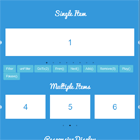angular-slick-carousel
angular 2 above take a look https://github.com/devmark/ngx-slick
Angular directive for slick-carousel
Summary
Usage
- Using bower to install it.
bower install angular-slick-carousel - Add
jquery,angular,slick-carouselandangular-slick-carouselto your code.
<link rel="stylesheet" href="../bower_components/slick-carousel/slick/slick.css"> <link rel="stylesheet" href="../bower_components/slick-carousel/slick/slick-theme.css"> <script src="../bower_components/jquery/jquery.js"></script> <script src="../bower_components/angular/angular.js"></script> <script src="../bower_components/slick-carousel/slick/slick.js"></script> <script src="../bower_components/angular-slick-carousel/dist/angular-slick.min.js"></script>- Add the sortable module as a dependency to your application module:
slickCarousel
var myAppModule = angular.module('MyApp', ['slickCarousel'])This directive allows you to use the slick-carousel plugin as an angular directive. It can be specified in your HTML as either a <div> attribute or a <slick> element.
<slick infinite=true slides-to-show=3 slides-to-scroll=3> ... </slick> <slick settings="slickConfig" ng-if="numberLoaded"> </slick>Attributes & Event
settings: optional Object containing any of the slick options. Consult here.
enabledshould slick be enabled or not. Default to true. Example belowmethodoptional containing slick method. discussed below in detaileventoptional containing slick event
$scope.slickConfig = { enabled: true, autoplay: true, draggable: false, autoplaySpeed: 3000, method: {}, event: { beforeChange: function (event, slick, currentSlide, nextSlide) { }, afterChange: function (event, slick, currentSlide, nextSlide) { } } };Enable/disable slick
Slick can be easily switched on and off by using enabled settings flag.
$scope.slickConfig = { enabled: true, } $scope.toggleSlick = function() { $scope.slickConfig.enabled = !$scope.slickConfig.enabled; } <slick settings="slickConfig"> ... </slick> <button ng-click="toggleSlick()">Toggle</button>Method
- All the functions in the plugin are exposed through a control attribute.
- To utilize this architecture, and have two-way data-binding, define an empty control handle on scope:
$scope.slickConfig = { method: {} }- Pass it as the value to control attribute. Now, you can call any plugin methods as shown in the example.
<button ng-click="slickConfig.method.slickGoTo(2)">slickGoTo(2)</button> <button ng-click="slickConfig.method.slickPrev()">slickPrev()</button> <button ng-click="slickConfig.method.slickNext()">slickNext()</button> <button ng-click='slickConfig.method.slickAdd("<div>New</div>")'>slickAdd()</button> <button ng-click='slickConfig.method.slickRemove(3)'>slickRemove(3)</button> <button ng-click='slickConfig.method.slickPlay()'>slickPlay()</button> <button ng-click='slickConfig.method.slickPause()'>slickPause()</button>Slide data
For change slide content, you have to set ng-if to destroy and init it
- controller:
$scope.number = [{label: 1}, {label: 2}, {label: 3}, {label: 4}, {label: 5}, {label: 6}, {label: 7}, {label: 8}]; $scope.numberLoaded = true; $scope.numberUpdate = function(){ $scope.numberLoaded = false; // disable slick //number update $scope.numberLoaded = true; // enable slick };- html:
<script type="text/ng-template" id="tpl.html"> <h3>{{ i.label }}</h3> </script> <slick ng-if="numberLoaded"> <div ng-repeat="i in number"> <div class="" ng-include="'tpl.html'"></div> </div> </slick>Global config
config(['slickCarouselConfig', function (slickCarouselConfig) { slickCarouselConfig.dots = true; slickCarouselConfig.autoplay = false; }])FAQ
Q: After change data, could i keep the current slide index? A: For this directive, this will destroy and init slick when updating data. You could get current index by event. example:
$scope.currentIndex = 0; $scope.slickConfig = { event: { afterChange: function (event, slick, currentSlide, nextSlide) { $scope.currentIndex = currentSlide; // save current index each time } init: function (event, slick) { slick.slickGoTo($scope.currentIndex); // slide to correct index when init } } };Examples
Now to run the samples in your local machine you just need to run:
grunt serveso you will start a web server on http://localhost:8000
now acess the folder examples: http://localhost:8000/examples/#/





